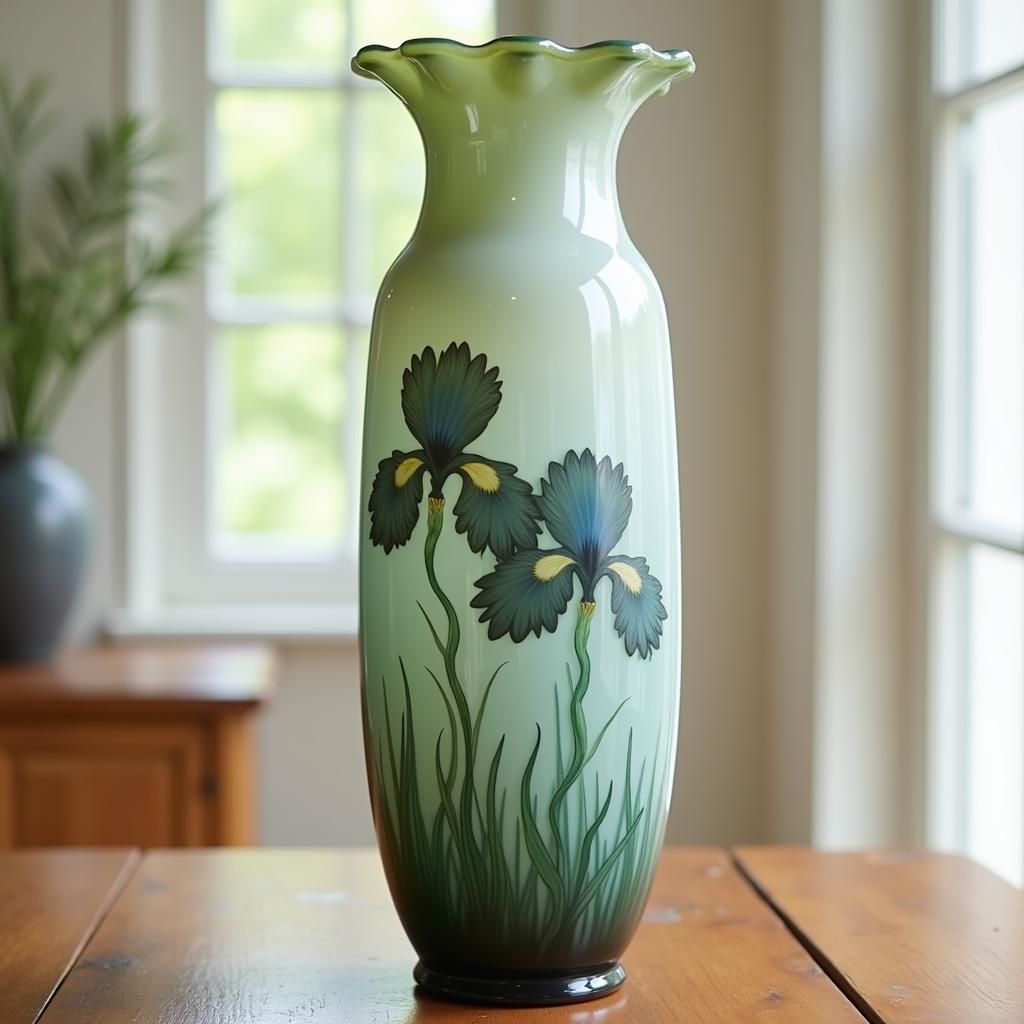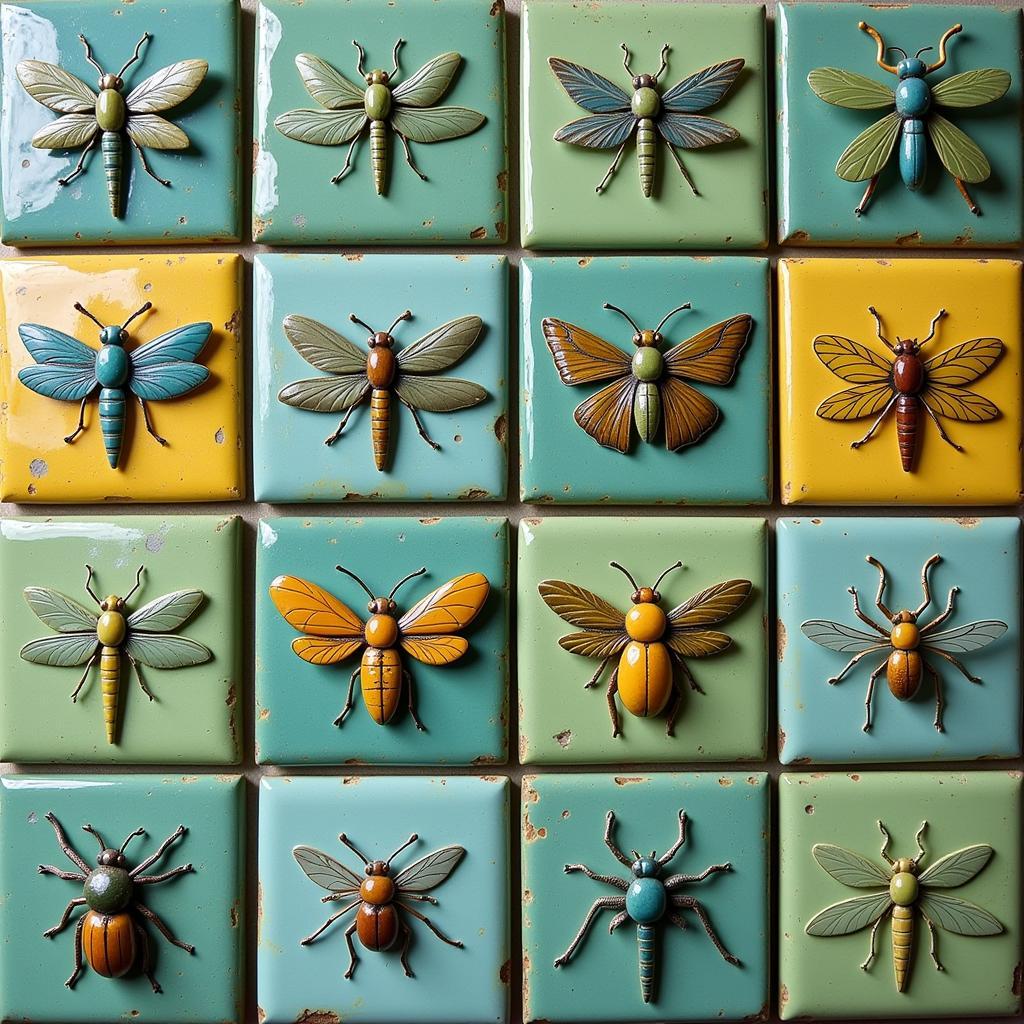Exploring the Beauty of Art Nouveau Ceramics
Art Nouveau Ceramics, a captivating blend of art and functionality, flourished between 1890 and 1910. This period saw a surge in innovative ceramic designs characterized by flowing lines, organic forms, and stylized floral motifs, creating a truly unique aesthetic that continues to inspire artists and collectors today. Check out our gallery art deco dahlia for similar artistic influences.
The Defining Characteristics of Art Nouveau Pottery
Art Nouveau ceramics distinguish themselves through several key features. The emphasis on natural forms, particularly flowers, insects, and flowing lines, is paramount. Think of the delicate curves of a lily pad or the intricate wings of a dragonfly, translated into the graceful shape of a vase or the subtle texture of a tile. Color palettes often embrace muted, earthy tones, alongside vibrant hues like iridescent greens, blues, and yellows, reminiscent of the natural world. Furthermore, Art Nouveau potters frequently incorporated innovative glazing techniques, producing striking iridescent and lustrous finishes.
What truly sets Art Nouveau pottery apart is its rejection of historical styles. Unlike preceding movements that often drew inspiration from the past, Art Nouveau embraced a forward-looking vision, paving the way for modernism in ceramic art.
Art Nouveau Ceramics: A Fusion of Art and Function
While aesthetically striking, Art Nouveau ceramics weren’t solely decorative. The movement embraced the idea of “total work of art,” integrating art into everyday life. This philosophy resulted in the creation of beautiful yet functional objects, from tableware to architectural tiles. Imagine serving tea in delicate, floral-themed cups and saucers, or admiring the intricate Art Nouveau tilework adorning a fireplace. This focus on functionality made Art Nouveau accessible to a wider audience, blurring the lines between fine art and craft. For those interested in tableware, consider exploring our arts and crafts tableware and arts crafts dinnerware collections.
 Art Nouveau Ceramic Vase with Floral Motifs
Art Nouveau Ceramic Vase with Floral Motifs
Key Figures in Art Nouveau Ceramics
Several prominent artists and manufacturers shaped the Art Nouveau ceramics landscape. Companies like Rookwood Pottery in the United States and workshops in France, such as those led by Émile Gallé and René Lalique, became renowned for their innovative designs and high-quality craftsmanship. These artists pushed the boundaries of ceramic art, experimenting with new forms, glazes, and decorative techniques.
Where can I find Art Nouveau ceramics?
Art Nouveau ceramics can be found in museums, antique shops, and auction houses. Dedicated collectors often scour these sources for rare and exceptional pieces. Prices for Art Nouveau ceramics can vary widely depending on the rarity, condition, and maker of the piece.
 Collection of Art Nouveau Tiles with Insect Motifs
Collection of Art Nouveau Tiles with Insect Motifs
What are the different types of Art Nouveau ceramics?
Art Nouveau ceramics encompass a wide range of objects, including vases, bowls, plates, tiles, and decorative figures. Each piece showcases the characteristic Art Nouveau style, but with variations in form, decoration, and function.
“Art Nouveau ceramics are not merely objects, they are embodiments of nature’s beauty, meticulously crafted into functional art.” – Isabelle Dubois, Art Historian
How can I identify authentic Art Nouveau ceramics?
Identifying authentic Art Nouveau ceramics requires careful examination of the piece’s style, marks, and craftsmanship. Consulting with experts and researching reputable sources can help authenticate a piece. The fluidity of the lines, the natural motifs, and the unique glazing techniques are key indicators of authenticity. Consider exploring the beauty of iridescent art glass for more examples of similar artistic techniques.
Conclusion
Art Nouveau ceramics continue to fascinate and inspire with their unique blend of art and nature. These beautiful and functional objects provide a glimpse into a period of artistic innovation, offering collectors and enthusiasts a tangible connection to the past. Whether you are drawn to the graceful lines, the organic forms, or the vibrant colors, Art Nouveau ceramics offer a timeless appeal that transcends generations.
FAQ
- What is the main characteristic of Art Nouveau ceramics? The emphasis on natural forms, flowing lines, and stylized motifs.
- When did the Art Nouveau movement flourish? Between 1890 and 1910.
- Who are some prominent Art Nouveau ceramic artists? Émile Gallé and René Lalique.
- Where can I find Art Nouveau ceramics for sale? Museums, antique shops, and auction houses.
- What are some common Art Nouveau ceramic objects? Vases, bowls, plates, tiles, and figures.
- How can I tell if an Art Nouveau ceramic piece is authentic? Examine the style, marks, and craftsmanship, and consult with experts.
- Why are Art Nouveau ceramics still popular today? Their unique aesthetic, blending art and nature, continues to resonate with collectors and enthusiasts.
“The beauty of Art Nouveau ceramics lies in their ability to capture the essence of nature in a tangible and functional form.” – Antoine Moreau, Ceramics Expert
Need help with Art Nouveau Ceramics or other art forms? Contact us! Phone: 02462573573, Email: [email protected] or visit us at Savico Megamall, 7-9 Đ. Nguyễn Văn Linh, Gia Thụy, Long Biên, Hà Nội 10000, Việt Nam. Our customer service team is available 24/7.


